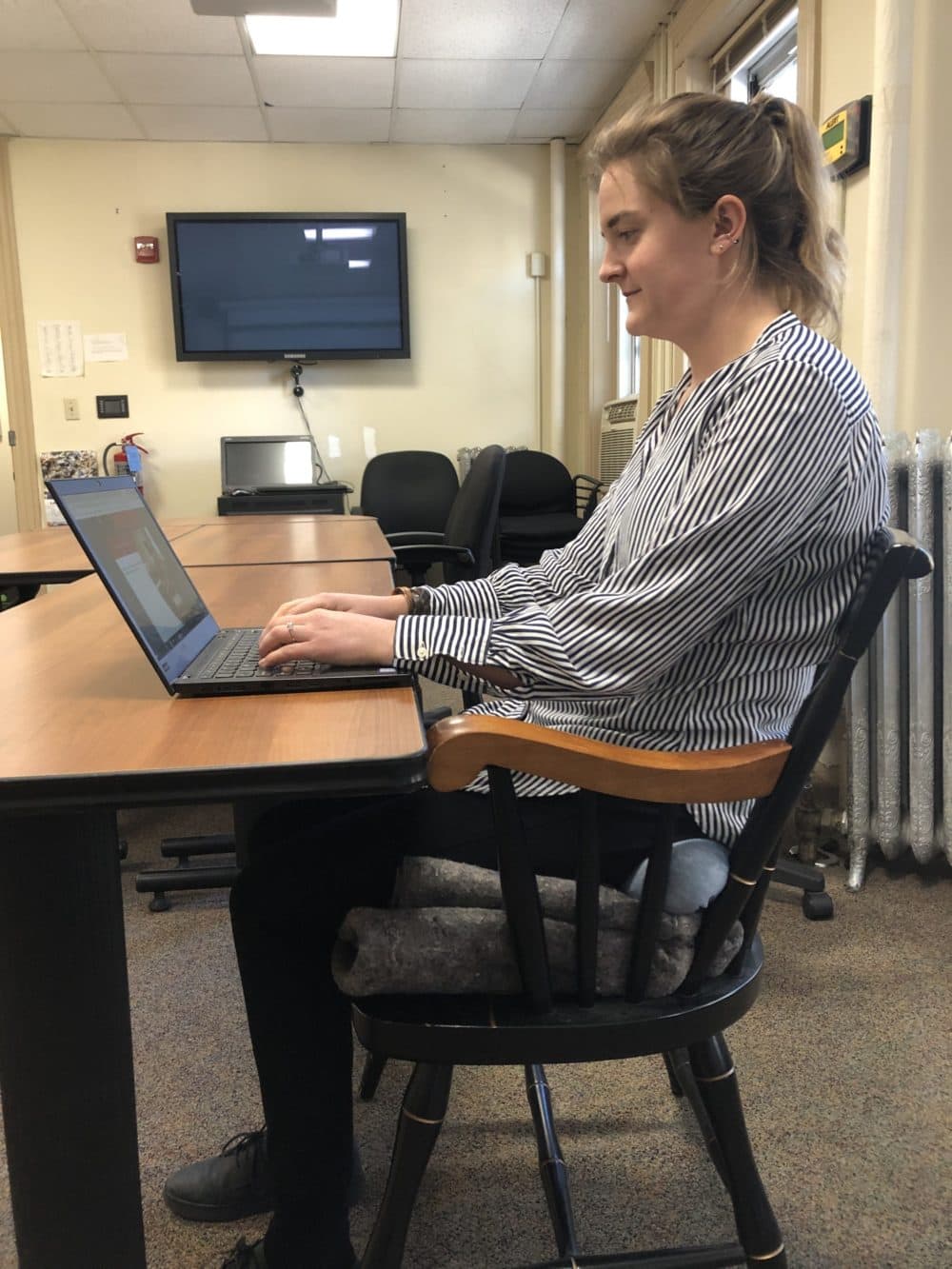Advertisement
Coronavirus Coverage
7 Ergonomic Tips To Help Save Your Aching Neck And Back While Working From Home

Do you have a bad back, a kink in your neck or knot in your shoulder you can trace back to when you started working from home due to the coronavirus pandemic?
It might be time to start thinking more about the ergonomics of your work-from-home setup.
Speaking with WBUR's All Things Considered, Carolyn Herkenham, a senior specialist and industrial hygienist in the Environmental Health and Safety Department at Boston University, offered some tips on ergonomic best practices for those working from home in the pandemic.
Working-From-Home Tips
Stay Off The Couch
I'm hearing a lot about people working from their couches, working on the floor and on their coffee tables.
When you're sitting, you do want to be in as neutral of a position as possible. That means you want your spine to be similar to how it is when you're standing. So when you're sitting on the couch, you're actually promoting your spine to a curve in the opposite direction, which can actually increase pressure on your spine up to 85%.
Sit Up...
What I do to stay upright is I push the height of my chair as high as possible.
When I am lower in my chair, I find that I have to really lift my arms and wrists up to meet the keyboard of my laptop. So when I bring my chair up as high as possible, I'm more of a neutral position with my shoulders and my arms to match the keyboard. And it's just much more comfortable. And it doesn't promote any shoulder strain or any arm strain when you're lifting up your arms.
If you can't lift your seat up, I would honestly just use pillows or cushions to try to keep you as high as possible. The issue with that, then, is that your legs are likely dangling off the chair; that could cause numbness in your legs. So it's a really great idea to just take any of those Amazon boxes you have lying around or books and prop them underneath your feet to give your feet a little lift so you don't have any numbness or tingling in your thighs.
...And Sit Back
CH: Neck strain is likely from when you're leaning over to look at your monitor or your back is leaning forward, but your head is up looking at your monitor. The best thing you can do is try to really use the back of your chair. And again, if you have a regular kitchen chair, I would suggest putting a pillow on the back of your chair and try to really use the full back of your chair, because if you're leaning forward, then it creates next strain when you're looking up at your monitor. You don't want to look up.
So ideally, you will actually when you're just using a laptop, it's the best strategy to actually keep put your laptop on a box or give yourself give the laptop maybe four inches of height because you actually want your eyesight to be in the top quarter of your monitor, which sounds really high, but it's actually important.
Protect Your Wrists When Typing
So a common complaint we get here is that people have wrist pain. And that's mostly because at home, you have contact with your wrist directly on a keyboard. And that contact stress could actually potentially lead to carpal tunnel syndrome or tendinitis issues. So when you're typing, it's really important to contact the computer with your palms as much as possible versus having contact with the desk and your wrist. And the reason is because your wrists are much more sensitive and they don't have that meaty protection like your palms do. So it's really a good idea to avoid risk stress by using your palms as your main form of contact when you're keyboarding on your computer or your desk.
Spare Your Eyes
CH: If you want to try to reduce eyestrain, there's a "20-20-20" rule. So if you're looking at your computer screen for 20 minutes, for 20 seconds, you should look away from your computer for 20 seconds at something that's 20 feet away every 20 minutes.
Keep It Moving
CH: It's really important to try to move around as much as possible. What causes the most strain in your muscles is when you're completely static. So it's really a good idea to if you're on a zoom meeting or on the phone, walk around a little bit around the office or your house. If you get a chance to go out for a lunch break and take a walk outside.
I know it is very challenging because a lot of us are sedentary at our chairs and desks. But if you have any opportunity, it's kind of a fun creative exercise to come up with ways you can stand or even just if you have the ability to reposition your chair. And if you're lucky enough to move back and forth in an office chair, that's a form of movement that will help you in the long run.
So honestly, I'd say every 30 minutes would be a good idea to at least change your position and get out of your chair. Drink a lot of water. That's the best way to get up out of your chair more often.
Make Your Own Space
CH: One piece of advice I'd really emphasize to folks is that you should definitely designate a space that's just for you. I know this can be tricky, but it's really important to customize. You should really tailor your office space at work to your home space as much as possible. It really puts you in the mindset of working. If you have designated spaces just for your own, you can just get right into work because everything's all set up for you instead of spending time jumping from the couch to the coffee table to the bathroom or wherever else.
This segment aired on May 26, 2020.

